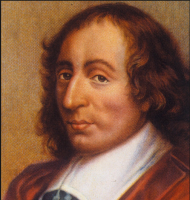










Blaise Pascal was a French mathematician, physicist, inventor, writer and Christian philosopher. He was a child prodigy who was educated by his father, a tax collector in Rouen. Pascal's earliest work was in the natural and applied sciences where he made important contributions to the study of fluids, and clarified the concepts of pressure and vacuum by generalizing the work of Evangelista Torricelli. Pascal also wrote in defense of the scientific method.
In 1642, while still a teenager, he started some pioneering work on calculating machines. After three years of effort and fifty prototypes,he built 20 finished machines (called Pascal's calculators and later Pascalines) over the following ten years,establishing him as one of the first two inventors of the mechanical calculator.
Pascal was an important mathematician, helping create two major new areas of research: he wrote a significant treatise on the subject of projective geometry at the age of 16, and later corresponded with Pierre de Fermat on probability theory, strongly influencing the development of modern economics and social science. Following Galileo and Torricelli, in 1646, he refuted Aristotle's followers who insisted that nature abhors a vacuum. Pascal's results caused many disputes before being accepted.
In 1646, he and his sister Jacqueline identified with the religious movement within Catholicism known by its detractors as Jansenism.His father died in 1651. Following a religious experience in late 1654, he began writing influential works on philosophy and theology. His two most famous works date from this period: the Lettres provinciales and the Pensées, the former set in the conflict between Jansenists and Jesuits. In that year, he also wrote an important treatise on the arithmetical triangle. Between 1658 and 1659 he wrote on the cycloid and its use in calculating the volume of solids.
Pascal had poor health, especially after his 18th year, and his death came just two months after his 39th birthday.
Early life and education
Pascal was born in Clermont-Ferrand; he lost his mother, Antoinette Begon, at the age of three.His father, Étienne Pascal (1588–1651), who also had an interest in science and mathematics, was a local judge and member of the "Noblesse de Robe". Pascal had two sisters, the younger Jacqueline and the elder Gilberte.
In 1631, five years after the death of his wife,Étienne Pascal moved with his children to Paris. The newly arrived family soon hired Louise Delfault, a maid who eventually became an instrumental member of the family. Étienne, who never remarried, decided that he alone would educate his children, for they all showed extraordinary intellectual ability, particularly his son Blaise. The young Pascal showed an amazing aptitude for mathematics and science.
Particularly of interest to Pascal was a work of Desargues on conic sections. Following Desargues' thinking, the 16-year-old Pascal produced, as a means of proof, a short treatise on what was called the "Mystic Hexagram", Essai pour les coniques ("Essay on Conics") and sent it—his first serious work of mathematics—to Père Mersenne in Paris; it is known still today as Pascal's theorem. It states that if a hexagon is inscribed in a circle (or conic) then the three intersection points of opposite sides lie on a line (called the Pascal line).
Pascal's work was so precocious that Descartes was convinced that Pascal's father had written it. When assured by Mersenne that it was, indeed, the product of the son not the father, Descartes dismissed it with a sniff: "I do not find it strange that he has offered demonstrations about conics more appropriate than those of the ancients," adding, "but other matters related to this subject can be proposed that would scarcely occur to a 16-year-old child."
In France at that time offices and positions could be—and were—bought and sold. In 1631 Étienne sold his position as second president of the Cour des Aides for 65,665 livres.The money was invested in a government bond which provided if not a lavish then certainly a comfortable income which allowed the Pascal family to move to, and enjoy, Paris. But in 1638 Richelieu, desperate for money to carry on the Thirty Years' War, defaulted on the government's bonds. Suddenly Étienne Pascal's worth had dropped from nearly 66,000 livres to less than 7,300.
Like so many others, Étienne was eventually forced to flee Paris because of his opposition to the fiscal policies of Cardinal Richelieu, leaving his three children in the care of his neighbor Madame Sainctot, a great beauty with an infamous past who kept one of the most glittering and intellectual salons in all France. It was only when Jacqueline performed well in a children's play with Richelieu in attendance that Étienne was pardoned. In time Étienne was back in good graces with the cardinal, and in 1639 had been appointed the king's commissioner of taxes in the city of Rouen — a city whose tax records, thanks to uprisings, were in utter chaos.
In 1642, in an effort to ease his father's endless, exhausting calculations, and recalculations, of taxes owed and paid (into which work the young Pascal had been recruited), Pascal, not yet 19, constructed a mechanical calculator capable of addition and subtraction, called Pascal's calculator or the Pascaline. Of the eight Pascalines known to have survived, four are held by the Musée des Arts et Métiers in Paris and one more by the Zwinger museum in Dresden, Germany, exhibit two of his original mechanical calculators.Though these machines are pioneering forerunners to a further 400 years of development of mechanical methods of calculation, and in a sense to the later field of computer engineering, the calculator failed to be a great commercial success. Partly because it was still quite cumbersome to use in practice, but probably primarily because it was extraordinarily expensive the Pascaline became little more than a toy, and status symbol, for the very rich both in France and elsewhere in Europe. Pascal continued to make improvements to his design through the next decade and he refers to some 50 machines that were built to his design.